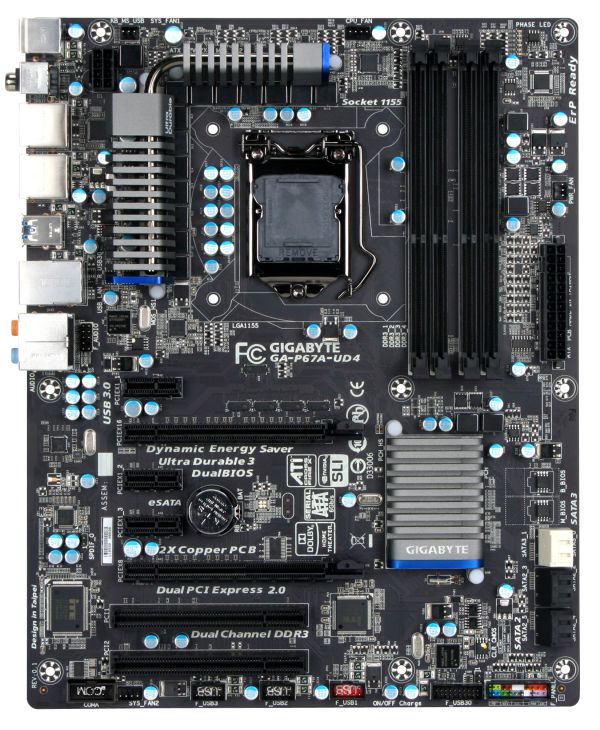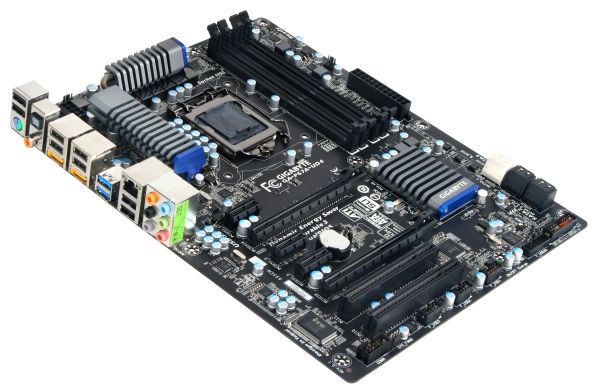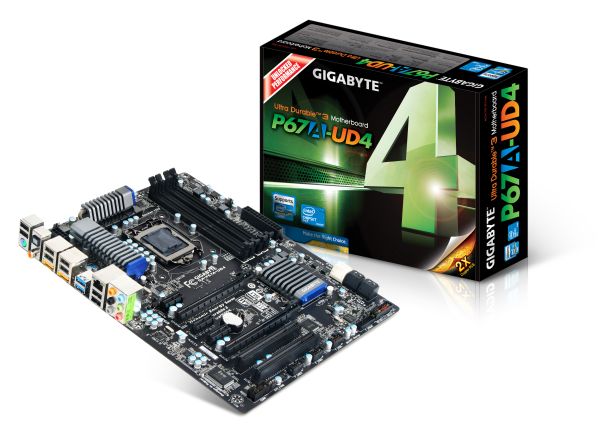The Battle of the P67 Boards - ASUS vs. Gigabyte at $190
by Ian Cutress on January 20, 2011 4:15 PM EST- Posted in
- Motherboards
- Gigabyte
- Asus
- P67
Gigabyte has five P67 motherboards up for the US Sandy Bridge release – the P67A-UD3, the P67A-UD3P, the P67A-UD4, the P67A-UD5 and the P67A-UD7. At least the naming scheme is as easy to follow as previous generations – the higher the last number, the more expensive the board and the more features on offer:
| P67A Series | |||||
| P67A-UD3 | P67A-UD3P | P67A-UD4 | P67A-UD5 | P67A-UD7 | |
| Price | $130 | $160 | $190 | $260 | $320 |
|
SATA 6 Gb/s SATA 3 Gb/s eSATA |
2 4 0 |
2 4 0 |
2 4 2 |
2 4 2 |
4 4 2 |
|
CrossFireX SLI |
Yes No |
Yes No |
Yes Yes |
Yes Yes |
Yes Yes |
|
USB 3.0 USB 2.0 |
2 12 |
4 14 |
4 14 |
8 10 |
10 8 |
| LAN | 1 | 1 | 1 | 1 | 2 |
| PCIe |
2 x16 (1 x16, 1 x4) |
2 x16 (1 x16, 1 x4) |
2 x16 (2 x8) |
3 x16 (2 x8, 1 x4) |
4 x16 (2 x16 or 4 x8) |
Visual Inspection
One of the first things I noticed about the P67A-UD4 was that it was not blue and white, like the majority of the Gigabyte motherboards have been recently that I have worked with. Predominantly featuring a black PCB, black PCIe connectors, black DIMM slots, black SATA 3Gb/s ports, a splash of white for SATA 6GB/s, silver chipset/FET coolers and a hint of old Gigabyte blue on those coolers is what we get this iteration. Not the whole range is like this – I have a H67 Gigabyte board on my desk here and that retains the blue and white credentials, as does the P67A-UD3.
The PCIe layout is slightly different to other P67 boards I have reviewed – with only two PCIe x16 slots (going to x8/x8 in dual GPU mode), there is an extra PCIe x1 slot on the board. In a dual GPU setup, this leaves two PCIe x1 and a PCI slot still free on the board, as well as a gap between dual slot GPUs to aid in cooling.
Fan headers on the board are located near the 8-pin power connector, one above the socket, one above the 24-pin power connector, and one below the PCIe slots, which would only be covered if you have a dual slot PCI card.
Gigabyte’s dual BIOS system is on this board. Yes, that is right – BIOS. No UEFI here. Well, that's not strictly true, as one of the latest BIOS updates at the time of writing (F6) implements an EFI into the BIOS, reportedly allowing bootable access to hard drives over 2.2TB. This is due to, as Gigabyte explained, that their board is actually UEFI, but without a proper GUI interface like other boards. They've used the old BIOS-style interface for now, as after years of plugging away they believe it's quick, stable and recognisable for consumers to understand. So underneath, it's truly 64-bit, meaning 2.2TB+ partition support is possible, and could also suggest that a new GUI is coming in the future. I asked about time-scale for this, but Gigabyte were undoubtedly tight-lipped about dates and implementations.
Visually, in terms of the board, there is not much else to say – the space between the socket and the PCI slots is virtually clear. There are no power, reset or clear CMOS buttons on board, neither is there a debug LED, and which is a real shame given that ASRock can do it on a $150 motherboard. Compared to the ASUS board, all the energy saving and turbo performance options are all software based – no easy flick of switches here.
Like the other P67 boards, the back panel is regular as well. Only a single PS/2 connector, 8 USB 2.0 ports, 2 USB 3.0 ports, 2 eSATA ports, S/PDIF Out connectors, a single gigabit Ethernet, and audio I/O.














137 Comments
View All Comments
7Enigma - Tuesday, January 25, 2011 - link
And in my experience I'm on the exact opposite. Built a gaming computer for my dad last summer. Started to randomly refuse to turn on after 2 months of use normal. After ruling out peripherals I pulled the HSF off and popped the CPU out to see a DISCONNECTED PIN on the mobo! Just sitting there on the ground like it had decided to fall off. Contacted Gigabyte through Newegg and received NO response. TONS of people were having similar issues both on their forums and on Newegg. I never received a response from them and ended up shelving the $130 mobo in my basement and buying a $140 Asus which has been rock-solid since installation last fall.Prior to this lack of customer support I was a huge fan of Gigabyte. My last 2 mobo's and video card were from them and I had nothing but praise when asked for a recommendation by friends/family. After the mobo fiasco and clearly being ignored (both myself and other enthusiasts) I've sworn off the company.
Makaveli - Thursday, January 20, 2011 - link
was that 920 D0 at stock speeds for the gaming test or overclocked?MeanBruce - Thursday, January 20, 2011 - link
Really feel it's worth waiting for the SandyBridge E LGA-2011 Asus Rampage IV Extreme X68 with Quad memory. That mobo will last through Ivy Bridge 22nm and maybe even into Haskins! In the meantime think I'll drive over to motor city and pick up some new rocks.vol7ron - Thursday, January 20, 2011 - link
Mmmm quad mem.Gothmoth - Thursday, January 20, 2011 - link
honest the H67 and P67 boards, as good as they are, are only to suck the money from the dumb enthusiasts who will not wait for the REAL DEAL.im not buying this stuff from, intel im waiting for Z68.
this overclocking/quick sync sillyness with the current chipsets really sux.
don´t know what intel is thinking but im not buying this crap thats for sure.
vol7ron - Thursday, January 20, 2011 - link
Second. It's actually a good marketing move to get rid of old partsMeanBruce - Thursday, January 20, 2011 - link
Mmmm Z68...strikeback03 - Friday, January 21, 2011 - link
Well, for some users the current offerings do make sense. If you are building a pure gaming system P67 shouldn't limit you any, as QuickSync isn't likely to be that important to you. Or our work computers, for example, will never be overclocked, so H67 boards would be fine for that use.That said, any mild enthusiast building some form of general-purpose system should probably wait for Z68. Dunno how Intel screwed that up, but it was dumb.
7Enigma - Tuesday, January 25, 2011 - link
Here here. I'll read the reviews for Anandtech but wouldn't touch this junk with a 10 foot pole. All the mobo manufacturers should be ticked at Intel for pulling this stunt as it doesn't affect them, just us as the end users and the mobo companies.GoodBytes - Thursday, January 20, 2011 - link
I agree with Beenthere.Since 2003-04 I notice ASUS cut on quality like no tomorrow. And their RMA service (well at least in Canada) is non-existant. Staff are rude, don't want to work, takes a month to process a replacement (this is NOT one of those once in a life time experience, this happened to me twice, and friends), and you get at the end someone else RMA'ed board with a different problem and packed with dust. When I got that as a second time, now they draw the line. I switch to Gigabyte. The boards feel quality over ASUS high-end boards, and unlike ASUS boards, they don't break soon after the warranty.
So yes, Gigabyte boards are more expensive for what you get in term of features, but in terms of life span and quality, Gigabyte wins by far. And I used to be a ASUS-fan, hence why I closed my eyes on my first bad experience, and the ones of my friends. Idiot I was.
When Gigabyte said that ASUS boards where crap.. they were not kidding... When that was said I was like most people "Pfff what are they talking about"... and now I see how crappy the boards are.
I really don't get what's so special about ASUS, and I am tiered of reviews who ignore quality and long term usability. Did the reviewer tested the computer to go into sleep, and hibernate several time in a row, and long period of sleep for a week, to see if the board wake up, and that EVERYTHING is fully function (every USB, Ethernet port(s) and eSATA (if any))? Does the review test the board under stress for really long time. How about leaving the computer turned on for a week, no reboot, how many time if failed (if any). How about heat dispersion, to ensure that the board can last longer over 3 years in a state of being overclocked. All this is ignored by all review sites... They all cover the same things... performance, warranty by years (and not actually SEEING how the server is, and the time it takes for a replacement), how it overclocks, and features numbers.
These are the moment where I wish that if I had more time, I would collect resources and start my own review site. But the problem is I am already anti-ASUS... so I can't even be legitimate.